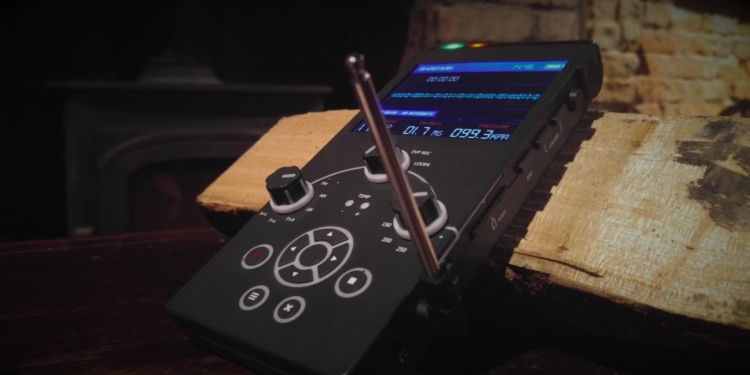Why Did I Buy A Ghost Detector If I Don’t Believe In Ghosts?

As you’ve probably noticed, I’ve been blogging quite a lot about the latest piece of ghost hunting kit on the market but many people have asked why I spent my hard earned money on a device that I don’t believe will work.
Not only do I not believe in spooks, spirits and spectres but I have no reason to believe that a GhostArk, a device which detects EVPs, changes in the electro-magnetic field and temperature changes, could possibly detect the presence of a ghost even if they did exist.
I love my GhostArk, I would honestly say it’s one of the coolest gadgets I have ever got my hands on and it does everything it says on the tin, it’s an all-in-one ghost hunting tool. This is in no way a dig at the product, if you believe in this stuff then you will love the GhostArk too.
The reason I want a GhostArk, quite simply, it’s really cool! It’s the same reason that I wanted all of the Ghostbusters toys as a kid and even now. How cool is this trap replica?
So what are ghost hunters actually looking to find with their meters? Well, the human brain uses minute electronic impulses so perhaps it’s this synaptic energy of a disembodied spirit that ghost hunter believe can be detected with an EMF meter or the GhostArk. The fact is however, if I hold an EMF meter near mine or anyone else’s head, there is no change in the EM field strength.
In fact, even if our brains did kick out a strong enough current it still wouldn’t be detected as EMF meters are designed to detect mains frequency (AC) EM fields in buildings and I’ve never heard any accounts that ghosts are mains powered.
Let’s assume for a minute than an EMF meter could detect electric frequencies of dead spirits, then shouldn’t they be able to detect living beings’ fields too? Like when I hold the device to my head? Or shouldn’t it alert me when a friend walks into the room?
While this important scientific link seems to allude researchers, it seems there is some evidence that shows how strong electro-magnetic fields can induce strange experiences at least in people exposed to them.
The effect can be seen when a subject’s head is placed between the poles of an alternating current magnet in a darkened room. As the field strength is increased, the person will begin to see a faint glow and strange lights.
If there’s any connection between EMF and hauntings then it is surely no more than this odd sensory anomaly, but quite how EM field strengths would get this high outside of a lab seems as much of a mystery to me.
Advertisement ‐ Content Continues Below.
Again, I’m not picking on GhostArk because as I’ve said it’s an awesome device but EMF isn’t all it does and it’s other features also fall into the category of bad science. It has four other tools built in, including ghost box, EVP recorder and temperature and pressure sensors.
But in the same way that intense electromagnetism can cause hallucinations, it’s conceivable that psychologically subtle changes in air temperature and pressure can create feelings of uncertainty in someone exposed to them, this could contribute to the environment feeling creepy, spooky or indeed haunted.
The way a basic EVP recording works is to use a sensitive microphone to pick up ambient noise, the audio is then played back and researchers listen for voices from beyond the grave in the recording.
The problem with doing this is that a lot of audio recorders boost the recording level to compensate for the fact that the room is silent, this massively boosts the level of ambient and background noise meaning a tiny shuffle or itch can become a booming sound when the recording is played back and the rest is in the eye, or in this case, ear of the beholder and their imagination. It’s faces in the fire, pareidolia, the psychological phenomenon where we look for patterns in what we’re seeing, our subconscious tries to bring order to chaos by showing us familiar shapes. It’s the reason why we see the man in the moon, the face on Mars and Jesus on a piece of toast.
The fact there is so much noise in these recordings is the reason why people hear so many disembodied voices as they look for patterns in the chaos. Ghost hunters, rather than trying to achieve as clean a recording as possible actually do the opposite and introduce noise by using devices like old cassette recorders. GhostArk itself is designed this way, its EVP recorder has a very wide band microphone, far wider than the frequency of human voices which means there’s a lot of hiss and rumble in the recordings. The designers of the devices have said it’s “more like listening to a cassette recording than audio from a digital recorder” and this is perfect for spotting EVPs, the more noise, the more chaos, the more chance the listener will pick out an odd sound.
If hisses and rumbles aren’t enough for you then ghost hunters have found a way to add even more noise into recordings and GhostArk has this feature built in too, it’s known as a ghost box or spirit box. Again, the aim of this feature is to capture EVPs but while the recording is being made the device rapidly flicks through the AM, MW and FM radio spectrum which means the device captures flashing bursts of white-noise, radio broadcasts and static. More noise and chaos than you could ever hope for with a raw cassette recording, the potential to hear voices through this method is very high.
So while many ghost hunting devices claim to be scientific, they are actually pretty unscientific and have evolved in a way that maximises the chances of rogue and enormous results. In a true, scientific environment, any piece of apparatus which introduces noise in to a test would be eliminated.
As I’ve said throughout this article, these faults aren’t only inherent to the GhostArk. The team at GhostArk have simply set out to incorporate these flawed devices which are already widely used into one device and they’ve done an excellent job of doing this by making a stylish device which rivals the Ghostbuster’s PKE Meter in terms of coolness.



